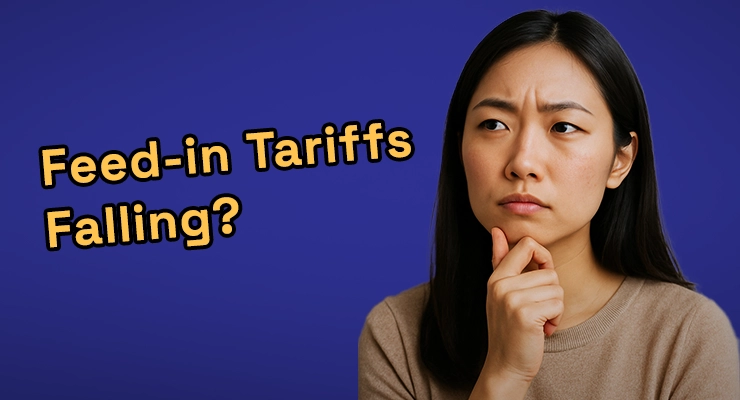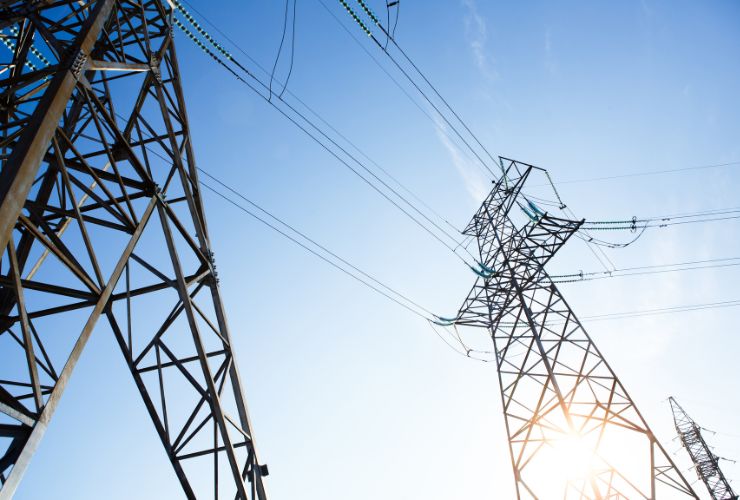
Fast read
A reduction in solar feed-in tariffs (FiTs) makes the return on investment (ROI) for a solar battery better, not worse. As the credit for exporting your excess solar energy to the grid shrinks, the financial benefit of storing that energy in a battery for your own use at night dramatically increases. This shift accelerates the payback period for batteries by prioritising valuable self-consumption over low-value exports.
How will a reduction in solar feed-in tariffs affect battery ROI?
For years, many Australian solar owners have seen their feed-in tariff—the small credit they receive for sending unused solar power back to the grid—as a key part of their system’s value. But with FiT rates steadily declining across the country, it’s natural to question how this changes the financial equation, especially when considering a significant investment like a home battery.
The logic might seem counterintuitive at first. If you’re earning less from your solar, how could it possibly be a better time to spend more on a battery? The answer lies in a fundamental shift in how you derive value from the energy you generate. A reduction in FiTs marks the turning point where storing your solar energy becomes significantly more profitable than selling it.
First, what exactly is a solar feed-in tariff?
A solar feed-in tariff is a rate your electricity retailer pays you for each kilowatt-hour (kWh) of surplus energy your solar panels generate and export to the grid. A decade ago, these tariffs were often very generous, designed to incentivise the uptake of solar technology.
However, as millions of Australian homes have installed solar, the grid is now flooded with cheap solar energy during the middle of the day. This oversupply has driven down the wholesale price of daytime electricity, leading energy retailers to reduce FiT rates. As of mid-2025, typical FiTs range from just 2 to 12 cents per kWh, a fraction of what they once were.
How a battery fundamentally changes your energy flow
Without a battery, your home operates on a simple energy hierarchy. Your solar panels first power your home’s needs during the day. Any excess, unused energy is automatically exported to the grid for a small FiT credit. When the sun goes down, you have no choice but to buy expensive electricity back from the grid.
A solar battery introduces a crucial new step. It sits between your solar system and the grid, acting as an energy reservoir. Now, when your panels produce more energy than you’re using, that excess power is used to charge the battery before it gets exported.
In the evening, instead of buying power from the grid, your home draws on the free, stored solar energy from your battery. You only export to the grid if your battery is full and you still have surplus solar, and you only import from the grid if your battery is depleted.
The new maths: Why lower feed-in tariffs make batteries more attractive
The business case for a battery hinges on a simple comparison: the value of the grid electricity you avoid buying versus the value of the FiT credit you give up.
Let’s use a real-world example to illustrate the impact of a falling FiT:
- Cost to buy electricity: Let’s say you pay 35c per kWh to import electricity from the grid in the evening.
- Old, higher feed-in tariff: Imagine your FiT was 12c per kWh.
- New, lower feed-in tariff: Now, your FiT has dropped to 5c per kWh.
Under the old FiT scenario, every kWh of solar energy you stored in your battery instead of exporting was worth 23c more to you (35c saved minus 12c foregone). This is a solid saving.
In the new, lower FiT scenario, you gain 30c for every kWh you store and use (by saving 35c and forgoing just 5c in export credit).
The financial incentive to store your energy has increased by almost 30% simply because the alternative—exporting it—has become less valuable. A lower FiT widens the gap between the cost of buying power and the credit for selling it, making the act of self-consumption the clear financial winner.
What other factors influence battery return on investment?
While the FiT rate is a powerful driver, it’s part of a larger picture. Your personal ROI will also depend on:
- Your energy consumption patterns: Households that use a lot of energy in the evening (for cooking, heating/cooling, and entertainment) will see faster paybacks because they are offsetting more expensive grid power.
- The price you pay for grid power: The higher your electricity tariff, the more money you save for every kWh you self-consume from your battery.
- Upfront system cost: The total price of the battery and installation is critical. Thankfully, costs are decreasing, and the federal government’s Cheaper Home Batteries Program, which began in July 2025, can significantly reduce the initial outlay.
- System efficiency: A well-designed system maximises the energy you can store and use. This often involves pairing a quality battery with a capable hybrid inverter, like those from Sungrow, which can efficiently manage the flow of energy between your panels, battery, and home, all through a single device.
Questions to ask yourself and your installer
Thinking about a battery is a big decision. To see if it’s right for you, it’s essential to move from general concepts to your specific situation. Before committing, find the answers to these questions:
- How much electricity do I typically use per day, and what portion of that is outside of daylight hours?
- Looking at my recent bills, how much solar energy am I currently exporting to the grid each day?
- Based on my actual usage data and the current FiT, can an installer provide a detailed payback calculation for a specific battery system?
- What is the right size battery for my home? It should be large enough to cover most of your evening usage without being oversized, which adds unnecessary cost.
Your path to energy independence
Viewing a reduction in feed-in tariffs as a negative signal for solar is a legacy mindset. Today, the smartest way to maximise your solar investment is to use as much of your own clean energy as possible. Falling FiTs are not a penalty; they are a clear market signal that the era of energy self-sufficiency has truly begun. A battery transforms your solar panels from a simple daytime appliance into a comprehensive energy solution that works for you day and night.
If you are trying to make sense of your energy bills and find accredited local experts who can provide detailed financial modelling, Your Energy Answers offers a free, independent service to connect you with trusted professionals in your area.



